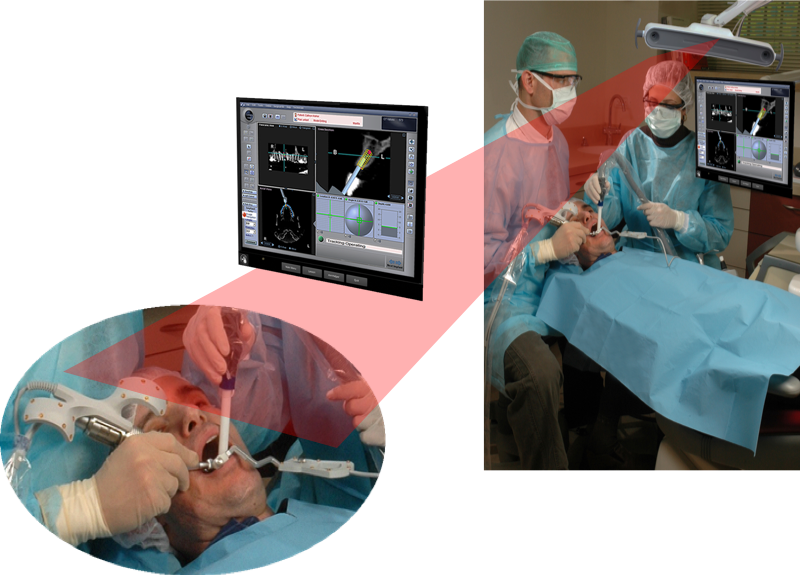What You Need to Know When Comparing 3D Navigation Systems for Placing Dental Implants
IGI Navigation Real Time Technology Dental Implants Demo on Jaw Model. (4:13) (Live Surgery video available) from Image Navigation Ltd. on Vimeo.
At first glance, most image navigation systems
for placing dental implants look quite similar.
Looks can be deceiving.
Here is what you need to know
See this screenshot of the IGI field-of-view. The lower right array is the patient-tracker. There is no ambiguity as to the location of the handpiece or tracker.
NOTE: You can test a system’s tracking fluency by dragging the handpiece from molar to contra-lateral molar. You can also test the onscreen tracking (both mandible and maxilla) by moving the handpiece abruptly from one spot to a new spot 5 cm away while looking at the screen.

The IGI-Image Guided Implantology navigation system offers cutting-edge technology, superior ergonomics, and outstanding performance.
IGI’s proprietary camera and active LED (light emitting diode) tracking system were specifically engineered for dental implant surgeries.
The LEDs on the IGI system work at the speed of light, with no observable lag or skipping, allowing one to know the current position of the drill at all times.
The majority of 3D-navigation companies use passive tracking systems that rely on a video camera to track patterns on the handpiece and patient tracker. Passive tracking systems require heavy computer algorithms for even the slightest movement, causing significant real time lag when comparing the actual drill location, angle, and depth to what is seen on the screen.
Passive tracking systems are typically utilized in other fields of medicine, where the requirement for accuracy is much less than in dental implant surgery.
The IGI patient-tracker is small, flat and out-of-the-way. This is a distinct advantage over other systems that have a fixed-position camera, and a barrel-shaped or large patient-tracker that can block your hands from a normal working position.

IGI’s proprietary wide field-of-view camera,
follows your drill on-screen without losing the image during surgery.
The IGI camera is also easy to reposition.
IGI 1: Casap, Nardy et al. “Navigation surgery for dental implants: assessment of accuracy of the image guided implantology
system.” Journal of oral and maxillofacial surgery : official journal of the American Association of Oral and Maxillofacial
Surgeons vol. 62,9 Suppl 2 (2004): 116-9. doi:10.1016/j.joms.2004.06.028
IGI (Elian): Elian, Nicolas et al. “Precision of flapless implant placement using real-time surgical navigation: a case series.” The
International journal of oral & maxillofacial implants vol. 23,6 (2008): 1123-7.
MiniLOCK data reported from R&D division
NEOCIS: Neugarten, Jay M. “Accuracy and Precision of Haptic Robotic-Guided Implant Surgery in a Large Consecutive
Series.” The International journal of oral & maxillofacial implants vol. 39,1 (2024): 99-106. doi:10.11607/jomi.10468
X-Nav: Nagata K, Okubo M, Saito K, Nakashizu T, Atsumi M, Kawana H. Verification of the accuracy of dynamic navigation for
conventional and mouthpiece methods: in vivo study. BMC Oral Health. 2024 May 22;24(1):596. doi: 10.1186/s12903-024-04327-1.
PMID: 38778269; PMCID: PMC11112779.
Navident (both numbers): Jorba-García, Adrià et al. “Accuracy of dental implant placement with or without the use of a dynamic
navigation assisted system: A randomized clinical trial.” Clinical oral implants research vol. 34,5 (2023): 438-449.
doi:10.1111/clr.14050
Falcon (Study 1&2), claimed in the presentation at this link (slides 14 and 16):
https://www.straumann.com/content/dam/media-center/straumann/en/documents/interactive-sales-presentation/490.859-en.pdf
The study cited at that link on their website is the following:
Edelmann C, Wetzel M, Knipper A, Luthardt RG, Schnutenhaus S. Accuracy of Computer-Assisted Dynamic Navigation in Implant
Placement with a Fully Digital Approach: A Prospective Clinical Trial. J Clin Med. 2021 Apr 21;10(9):1808. doi:
10.3390/jcm10091808. PMID: 33919257; PMCID: PMC8122675.
However, the results of that study do not seem to be consistent with the claims made on their website presentation, particularly the
1.53 mm number. The study involved 20 patients (16 lower jaw, 4 upper jaw)
Falcon (model): Spille, Johannes et al. “Comparison of implant placement accuracy in two different preoperative digital workflows:
navigated vs. pilot-drill-guided surgery.” International journal of implant dentistry vol. 7,1 45. 30 Apr. 2021,